EMD SD40-2
The EMD SD40-2 is a 3,000-horsepower (2,200 kW) C-C road switcher diesel-electric locomotive built by EMD from 1972 to 1989.
| EMD SD40-2 | |||||||||||||||||||||||||||||||||||
|---|---|---|---|---|---|---|---|---|---|---|---|---|---|---|---|---|---|---|---|---|---|---|---|---|---|---|---|---|---|---|---|---|---|---|---|
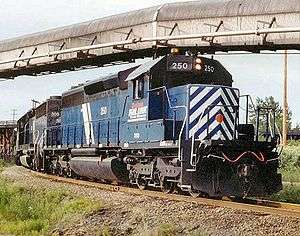 Montana Rail Link XDM SD40-2 diesel locomotive #250 at Everett, Washington, United States, January 1994. | |||||||||||||||||||||||||||||||||||
| |||||||||||||||||||||||||||||||||||
| |||||||||||||||||||||||||||||||||||
| |||||||||||||||||||||||||||||||||||
| |||||||||||||||||||||||||||||||||||
The SD40-2 was introduced in January 1972 as part of EMD's Dash 2 series, competing against the GE U30C and the ALCO Century 630. Although higher-horsepower locomotives were available, including EMD's own SD45-2, the reliability and versatility of the 3,000-horsepower (2,200 kW) SD40-2 made it one of the best-selling models in EMD's history, edged only by the GP9, and the standard of the industry for several decades after its introduction. The SD40-2 was an improvement over the SD40, with modular electronic control systems similar to those of the experimental DDA40X.
Peak production of the SD40-2 was in the mid-1970s. Sales of the SD40-2 began to diminish after 1981 due to the oil crisis, increased competition from GE's Dash-7 series and the introduction of the EMD SD50, which was available concurrently to late SD40-2 production. The last SD40-2 delivered to a United States railroad was built in July 1984, with production continuing for railroads in Canada until 1988, Mexico until February 1986, and Brazil until October 1989. As of 2013, nearly all built still remain in service.
The SD40-2 has seen service in Canada, Mexico, Brazil and Guinea. To suit export country specifications, General Motors designed the JT26CW-SS (British Rail Class 59) for Great Britain, the GT26CW-2 for Yugoslavia, South Korea, Iran, Morocco, Peru and Pakistan, while the GT26CU-2 went to Zimbabwe and Brazil. Various customizations led Algeria to receive their version of a SD40-2, known as GT26HCW-2.
Appearance and spotting features
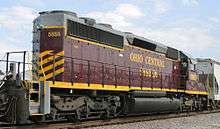
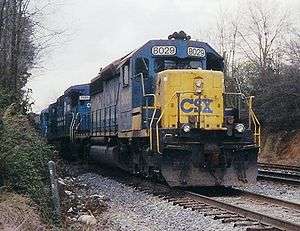
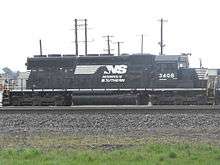
.jpg)
As the SD38, SD39, SD40, and SD45 shared a common frame, so too did the SD38-2, SD40-2, and SD45-2. It was 3 ft (0.91 m) longer than the previous models, giving a length of 68 ft 10 in (20.98 m) over the coupler pulling faces. The SD38-2 and SD40-2 shared the same basic superstructure, since they used the same 16-645 engine (in Roots-blown and turbocharged form respectively); the long hood was 18 inches (457 mm) longer than the SD38 and SD40, but since the increase in frame length was even greater, the SD38-2 and SD40-2 had even larger front and rear "porches" than the earlier models. These empty areas at front and rear are spotting features to identify the Dash 2 models of both units. The SD40-2 can be distinguished from the SD38-2 by its three roof-mounted radiator fans instead of two, and a single large exhaust stack instead of two smaller stacks.[1]
The increase in the frame length between the preceding 40 Series and the 40-2 Series six-axle locomotives was made to accommodate the new HT-C truck design, in which the traction motors all face the same direction, making the trucks longer. After a series of derailments involving Amtrak SDP40F units that were equipped with "hollow bolster" HT-C trucks, applied only to the SDP40F, Conrail ordered the SD40-2 units and several orders of SD50s with the older Flexicoil trucks, but the HT-C truck was vindicated and it ultimately went under most 40 Series, 50 Series and 60 Series six-axle locomotives, and this truck is still found under many remanufactured locomotives.
Some SD45 and SD45-2 units have been modified by replacing their 20-cylinder engine with the 16-cylinder removed from scrapped SD40-2 units; this was common on Union Pacific and possibly other railroads. In many cases these are identified by the owner as SD40-3, SD40M-2 or some such. Confusingly, what appears to be an SD45 is labeled as an SD40-2. Older SD40-2 units used in low-power modes such as yard switching or hump service have been de-turbocharged, resulting in the mechanical equivalent of a SD38-2. Units so modified may or may not be re-labeled.
There are several variations of the SD40-2 such as the SD40T-2s (Informally: T for tunnel motor; the actual EMD designation is "SD40-2 With Cooling System Modification", as stated on this model's EMD manuals) bought by the former Southern Pacific, and Denver and Rio Grande Western railroads; now operated by Union Pacific. The SD45 tunnel motor equivalent, the SD45T-2 model, was also utilized by Southern Pacific. Many tunnel motors were rebuilt and sold second-hand to a handful of American shortlines including, Bessemer and Lake Erie, Illinois Railway and Missouri and Northern Arkansas, as well as Canadian shortline Goderich-Exeter Railway. There is the SD40-2W (W for the 4-Window Safety Cab) bought and operated by the Canadian National railway. High-nosed versions of the SD40-2 were bought by Norfolk & Western, & Southern Railway. These units are now operated by the Norfolk Southern Railway (Resulting merger of N&W and Southern Railway). A narrow gauge version produced for Ferrovia Central Atlantico in Brazil is the BB40-2.
There are distinguishable differences between the EMD models and the Canadian GMD-built models. Most notable are the headlight configurations. The biggest giveaway is the rear light. GMD SD40-2s have a single beam, where EMD has twin-beam styled lights, usually placed next to each other. GMD models also have lights mounted on the nose, and EMD is above the cab between the numberboards. Some EMD variations have a nose headlight, although the headlight style and placement usually isn't the same as seen on the GMDs. Other features on the GMD models include the bell mounted above the cab between the numbers, triple-style classification lights above the numbers (since trains don't use classlights anymore, many locomotives have had them removed), and no numberboards on the back.
Three cabless SD40-2Bs were also rebuilt from standard SD40-2s by the Burlington Northern Railroad in the early 1980s. The units had been in collisions and BN decided that it was more economical to rebuild them without cabs. Canadian Pacific also owns a few SD40-2Bs. These were created by welding metal plates over the cab windows of many of its ex-Norfolk Southern and some of its original SD40-2s.
Additional specifications
| Main generator: | AR10 alternator |
|---|---|
| Traction motors: | 6 × D77/78 DC |
| Standard gearing: | 62:15 |
| Maximum speed with 62:15 gearing: | 65 mph (105 km/h) |
| Continuous TE with 62:15 gearing: | 83100 lb |
Original owners
| American SD40-2 orders | |||||
|---|---|---|---|---|---|
| Railroad | Quantity | Road numbers | Notes | ||
| Atchison, Topeka and Santa Fe Railway | 187 | 5020-5192, 5200-5213 | Most now in service with BNSF Railway | ||
| Burlington Northern Railroad | 835 | 6325–6334, 6348–6373, 6376–6385, 6700–6836, 6840–6847, 6850–6851, 6900–6928, 6950, 7000–7291, 7800–7940, 8000–8181 | Most now in service with BNSF Railway. 7167-7205, 7206-7235, & 8074-8089 were the only SD40-2s built by General Motors Diesel as exports to the United States, when EMD LaGrange IL plant was overloaded with orders. EMD sent the three orders to GMD London, Ontario. Burlington Northern #7149 and #7890 were LNG test units modified by energy conversions | ||
| Burlington Northern Railroad (Colorado and Southern Railway) | 27 | 900-925 980-996 | All of them went to BN, renumbered 6348-6373 6850-6950 | ||
| Baltimore and Ohio Railroad | 20 | 7600–7619 | Now in service with CSX Transportation | ||
| Chicago and North Western Railway | 135 | 6801–6935 | Most now in service with Union Pacific Railroad, 6847 donated and restored at the Illinois Railway Museum. | ||
| Conrail | 167 | 6358–6524 | Equipped with flexicoil trucks. Now renumbered and in service with CSX, Norfolk Southern, or leasing firms | ||
| Clinchfield Railroad | 5 | 8127–8129, 8131–8132 | Family Lines Paint, to Seaboard System, now in service with CSX Transportation | ||
| Illinois Central Gulf Railroad | 4 | 6030-6033 | 6031 was converted into 6200, 6033 was destroyed in a collision in Flora, Mississippi on February 6, 1994 | ||
| Kansas City Southern Railway | 46 | 637-692 | #637 was the very first SD40-2 constructed in January 1972. | ||
| Louisville and Nashville Railroad | 191 | 1259–1278, 3554–3612, 8000–8039, 8067–8086, 8095–8126, 8133–8162 | 8000s units delivered in Family Lines paint; all to Seaboard System, now in service with CSX Transportation. | ||
| Milwaukee Road | 90 | 21–30, 171–209, 3000–3040 | Now in service among several various railroads. #124 was exported to Guinea. | ||
| Missouri–Kansas–Texas Railroad | 37 | 600–636 | Most now in service with Union Pacific Railroad. Order based on Burlington Northern specifications for Pooling Service. | ||
| Missouri Pacific Railroad | 306 | 790–838, 3139–3321, 6020–6073 | Most now in service with Union Pacific Railroad. 790–838 & 3139–3321 lack dynamic brakes. 6020–6073 were based on Burlington Northern specifications for Pooling Services. Considered the heaviest SD40-2s ever built. | ||
| Oneida and Western Railroad | 8 | 9950–9957 | Not an actual railroad - purchased on Louisville & Nashville specifications. Later became BC Rail 743-750, 749 is now GECX 749 | ||
| Chicago, Rock Island and Pacific Railroad | 10 | 4790–4799 | Later became Illinois Central Gulf 6040-6049. Six are in service with Wisconsin and Southern Railroad | ||
| Seaboard Coast Line Railroad | 36 | 8040–8066, 8087–8094, 8130 | Delivered in Family Lines Paint, to Seaboard System, now in service with CSX Transportation | ||
| St. Louis–San Francisco Railway | 8 | 950–957 | Merged in Burlington Northern in 1980, numbered BN 6840-6847, same numbers in BNSF. Now in service with the BNSF Railway | ||
| Soo Line Railroad | 57 | 757–789, 6600–6623 | Most now in service with the Canadian Pacific Railway. #6623 is the last SD40-2 built in the United States in July 1984. | ||
| Southern Railway | 128 | 3201–3328 | Some sold to Canadian Pacific Railway. All other units rebuilt with low short hood; now in service with Norfolk Southern Railway. | ||
| Union Pacific Railroad | 686 | 3123–3239, 3243–3304, 3335–3399, 3410–3583, 3609–3808, 8000–8002, 8035–8099 | Several have been renumbered and others retired to leasers. 3200–3410 delivered with snoot noses. 3105 donated to RailGiants Train Museum along with a boxcar and a bay-window caboose and now sits on UP 4014's former spot. | ||
| Southern Pacific Railroad | 229 | 8230–8299, 8300–8329, 8327–8341, 8350–8371, 8377–8391, 8489–8573 | Model EMD SD40T-2. To Union Pacific, retired. #8278 was destroyed and scrapped in the San Bernardino train disaster. | ||
| Denver and Rio Grande Western Railroad | 73 | 5341–5413 | Model EMD SD40T-2. To Union Pacific, retired. #5371 Preserved at the Utah State Railway Museum at Ogden Utah. #5401(UP #9871) is preserved at the Colorado Railroad museum. | ||
| St. Louis Southwestern Railway | 10 | 8322–8326, 8372–8376 | Model EMD SD40T-2 | ||
| Canadian SD40-2 orders | |||||
| Railroad | Quantity | Road numbers | Notes | ||
| Algoma Central Railway | 6 | 183–188 | Units became WC 6000-6006 after the Wisconsin Central took over the Algoma Central. Now in service with Canadian National Railway. | ||
| British Columbia Railway | 17 | 751–767 | Purchased after complications arose from safety concerns on a recent order of MLW M630Ws. #767 is the last SD40-2 built in Canada in July 1985. | ||
| Canadian Pacific Railway | 486 | 5500-5560, 5565-5879, 5900-6069 9000-9024 | Units 9000-9024 are GMD SD40-2F. | ||
| Canadian National Railway | 123 | 5241–5363 | These units had the Canadian Safety Cab with 4 windows and were classified as SD40-2W | ||
| Ontario Northland Railway | 8 | 1730–1737 | These are the only SD40-2s built by GMD London without dynamic brakes. | ||
| Quebec, North Shore and Labrador Railway | 44 | 221–264 | Four engines now serve the short-line Wellsboro & Corning Railroad in northern Pennsylvania, hauling sand cars to support Marcellus shale hydraulic fracturing in the region. | ||
| Export SD40-2 orders | |||||
| Railroad | Quantity | Road numbers | Notes | ||
| Chemin de Fer Boké (Guinea) | 3 | 107–109 | Meter gauge 1,000 mm (3 ft 3 3⁄8 in) | ||
| Estrada de Ferro Carajás (Brazil) | 29 | 401–429 | Constructed by Equipamentos Villares S.A. (EVSA) and built to Irish Gauge (1,600 mm (5 ft 3 in)) specifications. #429 is the very last SD40-2 constructed in October 1989. | ||
| Ferrocarriles Unidos del Sureste (Mexico) | 4 | 601–604 | The only SD40-2s in México without dynamic brakes. | ||
| NdeM (Mexico) | 103 | 8700–8798, 13001–13004 | #13004 is the last SD40-2 built for México in February 1986. | ||
| RFFSA (Brazil) | 36 | 3711–3747 | The only SD40-2s constructed in Europe for a Brazilian customer in Irish Gauge (1,600 mm (5 ft 3 in)) by Material y Construcciones S.A. (MACOSA). | ||
| Mauritania Railway | 21 | CC101–CC121 | SDL40-2 variant for operating in high temperatures. | ||
Variants
SD40T-2
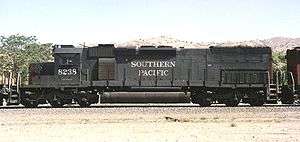
A variant of the SD40-2 was created for several western railroads for extended periods in tunnels and snow sheds. Originally purchased by Southern Pacific and Rio Grande railroads, these were transferred to the Union Pacific Railroad in 1996. They have since found their way into the used locomotive market and many have been sold to regional railroads around the U.S.
British Rail Class 59
Another variant of the SD40-2 was created for Foster Yeoman, a British quarrying and aggregates company, which features a unique body design specifically for the European railway markets. Designated as Class 59 the initial production batch of four locomotives entered service in 1986.
SD40-2W
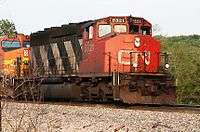
The GMD SD40-2(W) is a Canadian-market version of the SD40-2 diesel-electric locomotive, built for the Canadian National Railway by the Diesel Division of General Motors of Canada Ltd. (formerly General Motors Diesel) of London, Ontario; 123 were constructed between May 1975 and December 1980.
SD40-2F
The EMD SD40-2F was a locomotive operated by Canadian Pacific Railway. It's essentially an SD40-2 with a full cowl hood. CP was the only buyer, buying 25 units, numbered 9000-9024. All have been scrapped or sold.
SD40-2S
The EMD SD40-2S (also incorrectly known as the SD40-2SS or SD40SS) was an experimental test bed variant of the SD40-2. (UP 3805–3808).
These locomotives were fitted with improved engine blocks, larger turbochargers, and two-speed radiator fans which were expected to improve cooling and reliability. The four UP units, but not the five BN locomotives, were fitted with an extended long hood, about 28 inches (710 mm) longer, to take enlarged radiators. Instead of the standard seven access doors under the radiators, the units had eight.
It has been commonly believed these units were fitted with higher-capacity AR16 alternators, traction motors, possibly increased engine power, and Super Series wheel slip control; however, Don Strack's research in Union Pacific's archives has proven that the UP units at least were not so equipped.
After a year's testing, UP's locomotives were fitted with standard engines and turbochargers. It is probable that the BN locomotives were also similarly refitted. All BN units are still in service with successor BNSF Railway, while of the UP locomotives two remain in service with UP, renumbered to UP 3412 from UP 3806 and 3807. Former UP 3805 is now in service with the Iowa, Chicago and Eastern Railroad as ICE 6406, and former UP 3808 now belongs to the Evansville Western Railway as EVWR 6003.
Rebuilds
A number of SD40-2s have been rebuilt into other models. Some of the most unusual are the metre gauge BB40-2s for use in Brazil.
Conversely, several other models of EMD locomotive have sometimes been rebuilt to SD40-2 standards, including the SD40, SD45 and SD45-2. Normally, this consists of electrical upgrades (-2) and replacing the 20-cylinder prime mover with a 16-cylinder version, often built for GE Capital in Poland using EMD's manufacturing drawings and specifications. An outgrowth of this may be GE Transportation's second-sourcing of EMD repair parts.
The unusually troublesome SD50s have also been rebuilt into the equivalent of SD40-2s, rather than scrapping them. The 645F block and crankshaft are inherently good designs (indeed, the lessons learned with the 645F became part of the 710G); lowering the rating from 3,500 horsepower (2,600 kW) at 950 rpm to 3,000 horsepower (2,200 kW) at 900 rpm solved the mechanical and electrical reliability issues.
SD40-3
The Dash 3 suffix is not part of any official lineup, and is a loose designation for rebuilt Dash 2 series EMDs. One example of an SD40-3 rebuild program is the one conducted by CSX. It started in 2010 with 10 units upgraded and numbered 4000-4009; in 2011, 20 units went through the program and were numbered 4010-4029 and in 2012 another 20 units followed and were numbered 4030-4049.[2] CSXT 4040-4049 are painted in the new CSX "RAILCAR LOGO" paint scheme. CSX plans to rebuild 300 locomotives (CSXT 4000-4399). The plan has been to have the new units serve an additional 30 years and cost far less than brand new locomotives. The new cabs can withstand crashes better, have new heating and air-conditioning systems, a new control stand, including visual displays, a modern WABCO braking controller, and modernized starting systems. The engine retain the original 3,000 horsepower (2,240 kW) rating, with rated tractive power increased to 130,000 lb (58,970 kg) from the former 86,000 lb (39,010 kg) rating.
NS Admiral Cab SD40-2
Beginning in 2011, Norfolk Southern began rebuilding its former Norfolk and Western and Southern SD40-2 units with new cabs. Norfolk Southern calls them Admiral Cabs because the design came from a former admiral on the Norfolk Southern board of directors. Norfolk Southern has rebuild 143 SD40-2 units with new Admiral Cabs. The reason behind using a custom cab is because buying EMD cabs would require NS to pay for the construction and a fee to EMD. Admiral Cabs have benefits such as new crew area climate control, improved crashworthiness, new controls, and modified windows for reducing sun glare.
SD22ECO
The SD22ECO is an EMD SD40-2 or similar, repowered with an EMD 8-710-ECO engine. The resulting locomotive is rated at 2,150 horsepower (1,600 kW), and meets EPA Tier II emissions regulations. [3]
SD33ECO
The SD33ECO is another rebuild by Norfolk Southern in which the locomotive is re-powered with an EMD 12-710 prime mover. The locomotive is rated at 3,300 horsepower (2,500 kW) and meets EPA Tier 3 emissions regulations. These include various upgrades including an Admiral Cab and accessories to extend engine life. Unlike many other locomotive rebuilds, these units are partially government sponsored and assigned to specific areas in which funding comes from.
SD30C-ECO
The SD30C-ECO is an EMD SD40-2 re-powered with an EMD 12-710 prime mover. The locomotive is rated at 3,000 horsepower (2,200 kW) and meets EPA Tier 0 emissions regulations. [4]
SD40E3
The SD40E3 (exactly the same as an SD33ECO) is an EMD rebuild in which the locomotive is re-powered with an EMD 12-710 prime mover. The locomotive is rated at 3,300 horsepower (2,500 kW) and meets EPA Tier 3 emissions regulations. It uses a new EMD cab, and other electrical and mechanical improvements.
BB40-2
The BB40-2 is an EMD rebuild for Ferrovia Central Atlantico in Brazil. Since FCA is metre gauge, there was no longer enough room in the trucks for the original traction motors. Also, FCA does not have a sufficiently high load limit per axle to operate SD40-2s. Thus, they were rebuilt as B+B-B+B units, using the same trucks as the GE BB40-8, GE BB40-9 and GE BB40-9W. FCA also rebuilt EMD SD40T-2s in the same way, producing the EMD BB40T-2.
Preservation
In June 2009, Union Pacific had donated 3028 (former Chicago & North Western 6847) to the Illinois Railway Museum in Union, Illinois. The unit still wears its original factory paint from when it was built for the CNW in March, 1974. CNW 6847 was patched by UP in February, 2003, to UP 3028, and retired in December, 2008.[5] The locomotive has since had its UP patches removed, and CNW herald and numbers restored.
Union Pacific had traded SD40-2C #3105 and other equipment to the RailGiants Train Museum at Fairplex in Pomona, California for Union Pacific 4-8-8-4 #4014 "Big Boy", which UP restored to operational status in 2019. The #3105 locomotive was originally built in 1979 as Missouri Pacific #6027, and one of the few that the Missouri Pacific ordered with dynamic braking.[6] This is the only operational locomotive in the museum.
Union Pacific donated SD40-2 #9950 to Western America Railroad Museum in Barstow, California in 2004. 9950 was built in 1980 for the Missouri Pacific as their #3320.
In the Fall of 2018, Canadian Pacific donated SD40-2 5903 to the Canadian Railway Museum in Delson, Quebec, making it the first SD40-2 to be preserved in Canada.
In June of 2020, Norfolk Southern donated SD40-2 6162 to the Kentucky Steam Heritage Corp. 6162 was originally built for the Norfolk and Western in 1978 as N&W 6162. [7]
See also
References
- Gerald L. Foster (1996). A Field Guide to Trains of North America. Houghton Mifflin Harcourt. pp. 56–57. ISBN 0-395-70112-0.
- Ross, Jim (2015-09-26). "New power from old: CSX locomotive rebuild program preserves jobs in Huntington, WV". The State Journal. Archived from the original on 2015-08-30. Retrieved 2015-04-10.
- http://www.emdiesels.com/emdweb/company/more/062209_kcsrepower.html
- "Canadian Pacific orders additional SD30C-ECOs". Trains. 10 February 2015. Retrieved 16 February 2015. (subscription required)
- "IRM acquires an EMD SD40-2". Illinois Railway Museum. Retrieved June 22, 2009.
- "After 52 Years, No. 4014 Poised to Return to Rails". Union Pacific. Retrieved January 10, 2014.
- Kentucky Steam Heritage Corp https://www.kentuckysteam.org/post/kentucky-steam-acquires-norfolk-southern-sd40-2-locomotive?fbclid=IwAR16nOLMXG8rSAvGdHlBsHbUluntZWImPr9_jByAJ9k8CRrczSiHxyogn78. Retrieved June 19, 2020. Missing or empty
|title=(help)
External links
| External image | |
|---|---|
| Wikimedia Commons has media related to EMD SD40-2 locomotives. |